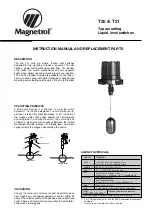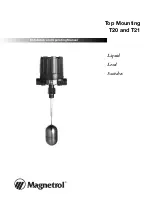
7
5. Output Description
1. Make sure provide power supply (L+/N-) in range of 20 to 250
(Vac or Vdc,50/60Hz)
and output relay (Relay or PNP/NPN before wiring. Detail please see Fig-1.
2. RT1 and RT2 are the testing points that easy user to verify the situation.
When the RT1 and RT2 are in electric short, it means the measured material
is in contact with the tuning fork level switch.
The Relay or PNP/NPN should be activated. In examining the tuning fork level
switch, user will finds it keep excitation.
3. Set OUTPUT MODE to FSH
,
Please refer to Fig 2 and 3:
Relay contact output:
a. When vibrating fork is not contacted with media or the bin is empty,Signal
is switched on. Relay N.O and COM are connected.
b. When vibrating fork is contacted with media, Signal is not switched on.
Relay N.C and COM are connected.
PNP/NPN contact output:
a. When vibrating fork is not contacted with media or the bin is empty, Signal
is switched on. Ourput transistor is connected and output functions.
b. When vibrating fork is contacted with media, Signal is not switched on.
MOSFET transistor is not connected and output doesn’t function.
4. Adjust OUTPUT MODE to FSL. (Please refer to Fig. 2, 3)
Relay contact output:
a. When vibrating fork is not contacted with media or the bin is empty, Signal
is not switched on. Relay N.C and COM are connected.
b. When vibrating fork is contacted with media, Signal is switched on. Relay
N.O and COM are connected.
PNP/NPN contact output:
a. When vibrating fork is not contacted with media or the bin is empty, Signal
is not switched on. Output transistor is not connected and output doesn’t
function.
b. When vibrating fork is contacted with media, Signal is switched on. Output
transistor is connected and output functions.
Summary of Contents for LTUR Series
Page 1: ...1 LTUR Series Tuning Fork Level Switch...
Page 2: ...2...
Page 5: ...5 3 Dimensions...
Page 11: ...11...
Page 12: ...12 M5734 0119...






























